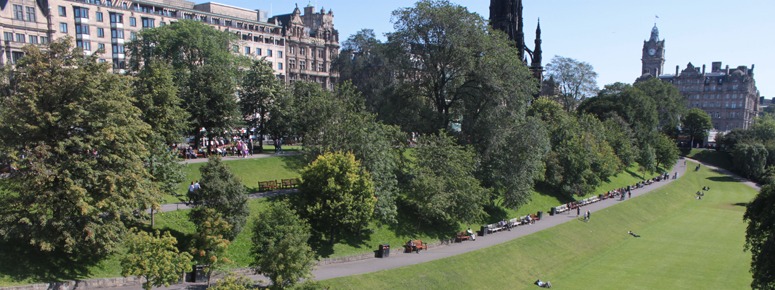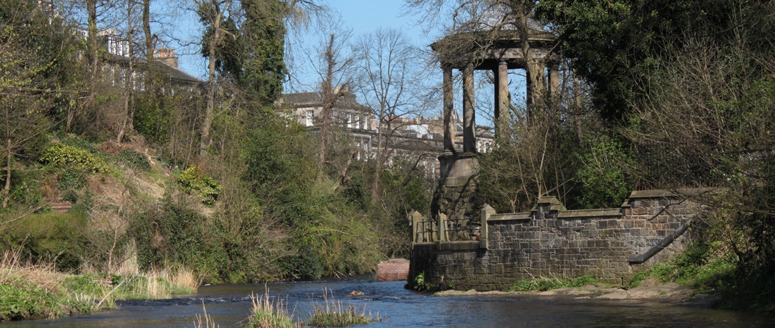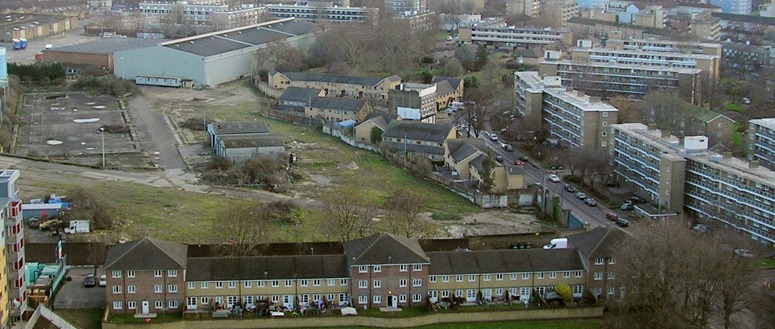Free street camping in Central London
image courtesy spinkney

 Following upon the discussion of Copenhagen’s Greenfinger Plan, here are two photographs of my hometown. They show examples of ‘urban landscapes’. BUT BUT BUT I do not regard the buildings as ‘urban’ bits and the green bits as ‘landscape’. I regard the scenic composition of buildings+landform+vegetation+paving+water (ie the Five Compositional Elements) as urban landscape compositions. Another reason for calling these examples Urban Landscapes is that they are beautiful. The below photograph of part of what was once of the most important early baroque-influenced gardens in England (Sayes Court, in Deptford) now lacks beauty and I would rather call it an ‘urban wasteland’ than an ‘urban landscape’. Sayes Court was nearly the first place to be saved from demolition by the National Trust. Things didn’t quite work out! Should any elements of the historic design be restored when Convoy’s Wharf is re-developed? The current design looks a bit Dubai-on-Thames but with duller architecture. The developers are Hutchinson Whampoa and the architects are bptw working with Aedas Architecture.
Following upon the discussion of Copenhagen’s Greenfinger Plan, here are two photographs of my hometown. They show examples of ‘urban landscapes’. BUT BUT BUT I do not regard the buildings as ‘urban’ bits and the green bits as ‘landscape’. I regard the scenic composition of buildings+landform+vegetation+paving+water (ie the Five Compositional Elements) as urban landscape compositions. Another reason for calling these examples Urban Landscapes is that they are beautiful. The below photograph of part of what was once of the most important early baroque-influenced gardens in England (Sayes Court, in Deptford) now lacks beauty and I would rather call it an ‘urban wasteland’ than an ‘urban landscape’. Sayes Court was nearly the first place to be saved from demolition by the National Trust. Things didn’t quite work out! Should any elements of the historic design be restored when Convoy’s Wharf is re-developed? The current design looks a bit Dubai-on-Thames but with duller architecture. The developers are Hutchinson Whampoa and the architects are bptw working with Aedas Architecture.
They paved paradise
And put up a parking lot
With a pink hotel, a boutique
And a swinging hot SPOT
Don’t it always seem to go
That you don’t know what you’ve got
‘Til it’s gone
They paved paradise
And put up a parking lot
They took all the trees
And put them in a tree museum
Then they charged the people
A dollar and a half just to see ’em
Don’t it always seem to go,
That you don’t know what you’ve got
‘Til it’s gone
They paved paradise
And put up a parking lot
We observed that Hemel Hempstead Water Gardens are a National Disgrace and that Hemel Hempstead Water Gardens are getting worse and worse and worse. This led to a number of people making contact to say ‘If someone started a Friends of the Water Gardens organisation then I would help’. This, I believe, is the best way forward. As our Prime Minister would say ‘It is a Big Society initiative which would cost Dacorum Borough Council little and make the standard of care much higher’. Jane Austen, however, would have said that ‘It is a truth universally acknowledged, that two old ladies with good skills can manage a garden better than a dozen youths in sweatshirts’. I would caution her against sexism but confirm that good gardens need brains more than they need brawn. A gardener has to know what to do, how to do it, when to do it, where to do it and why it is being done.
Britain is a nation of gardeners to a much greater extent than it is a nation of shopkeepers – and to a much greater extent than America. But UK public parks make hardly any use of volunteers. The UK National Trust, in comparison, makes extensive use of volunteer gardeners and in the USA it the normal way of managing public gardens and parks. New York City Department of Parks and Recreation, for example has a page for volunteering. So do US gardens open to the public, like Longwood and so do US botanical gardens like Missouri.
My suggestion to Dacorum Borough Council (DBC) is to provide an elegant little building with a verandah where volunteers can keep their tools, wash their hands, make tea, distribute seeds and keep an eye on the gardens. You can see how this would work at Phoenix Garden in London. It is an approach which would soon make the Hemel Hempsted Water Gardens a beautiful place and a social amenity. Old folks would go there to meet their friends and get healthy exercise. The Council might find its social services bill falling as fast as its parks maintenance bill. The lager drinkers one sometimes sees in the Water Gardens might change to a life of tea drinking and hard work. Younger volunteers might find that the skills learned from older gardeners leading to skilled employment. So come on DBC: why not make everyone happier and reduce the Council budget? Isn’t that your job?